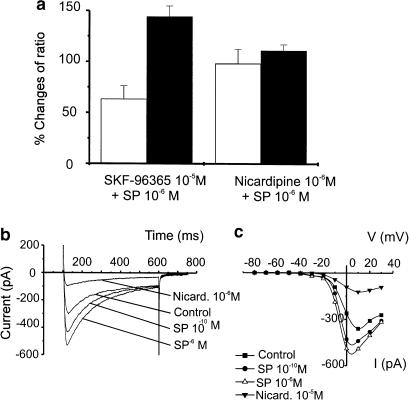Figure 3.
Increase of basal Ca2+ caused by SP is a result of activation of L-type Ca2+ current. (a) Comparison of the effects of pretreatment with SKF-96365 (10−5 M; blocker of receptor operated Ca2+ channels) and nicardipine (10−6 M; L-type Ca2+ channel blocker). SKF-96365 did not prevent the effects of SP (10−6 M) on Ca2+ puffs or basal Ca2+ (open bars show changes in Ca2+ transients in relation to control records, and closed bars show changes in basal Ca2+ in relation to control). Nicardipine blocked the effects of SP. (b) Inward currents activated in a colonic myocyte in response to depolarization from –80 to 0 mV in control conditions and after addition of SP (10−10 M), SP (10−6 M), and nicardipine (10−6 M) in the continued presence of SP (10−6 M) in the same cell. Small residual current after treatment with nicardipine is a voltage-dependent non-selective cation current that has been characterized previously (see Koh et al., 2001). (c) I/V curves demonstrating the increase in inward current after application of SP and reduction in inward currents after application of nicardipine. The current remaining after addition of nicardipine in (b,c) likely to be the dihydropyridine-insensitive, voltage-dependent nonselective cation current previously described in murine colonic myocytes (Koh et al., 2001). Nicardipine blocked the inward current activated by SP.

